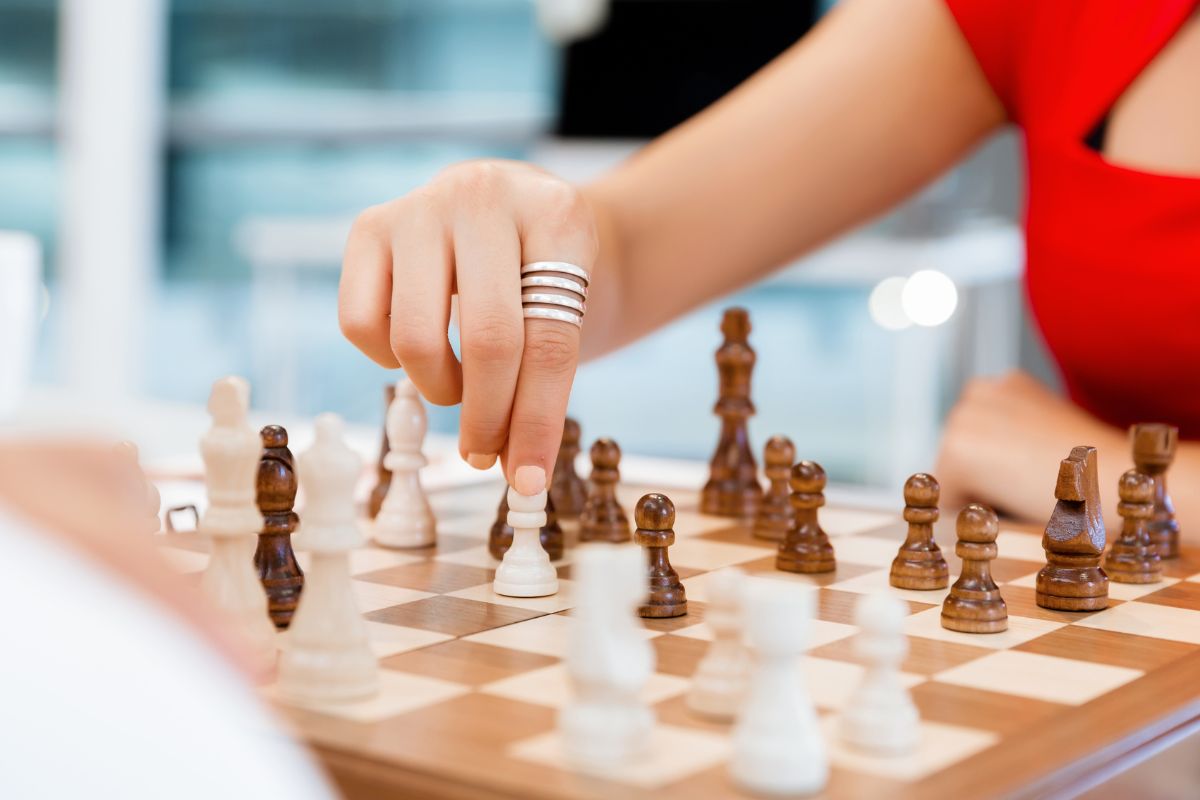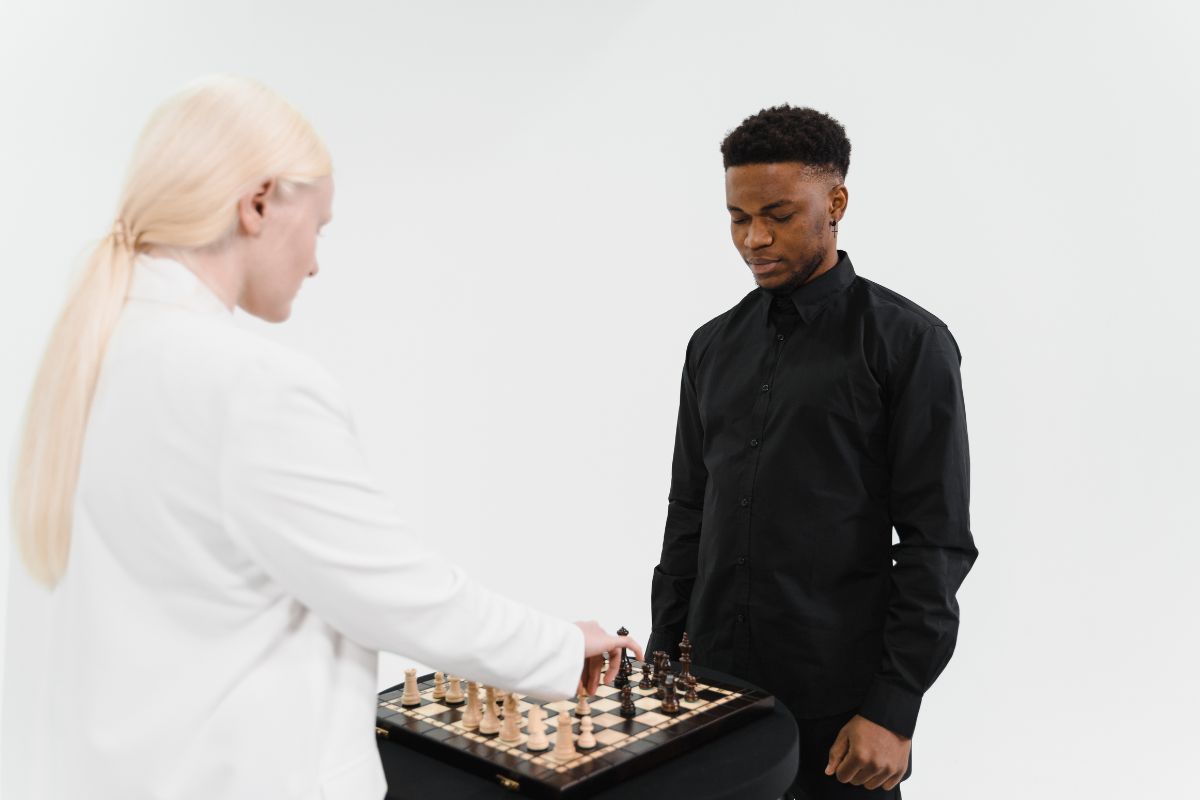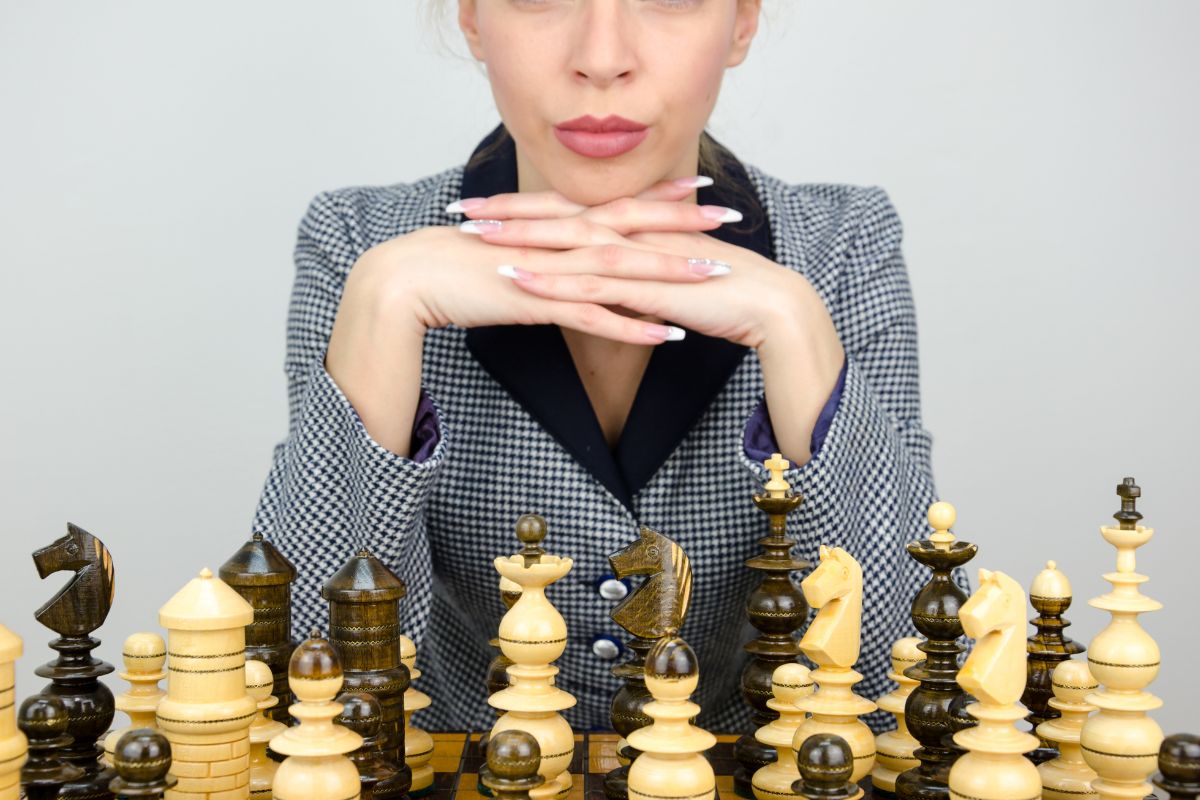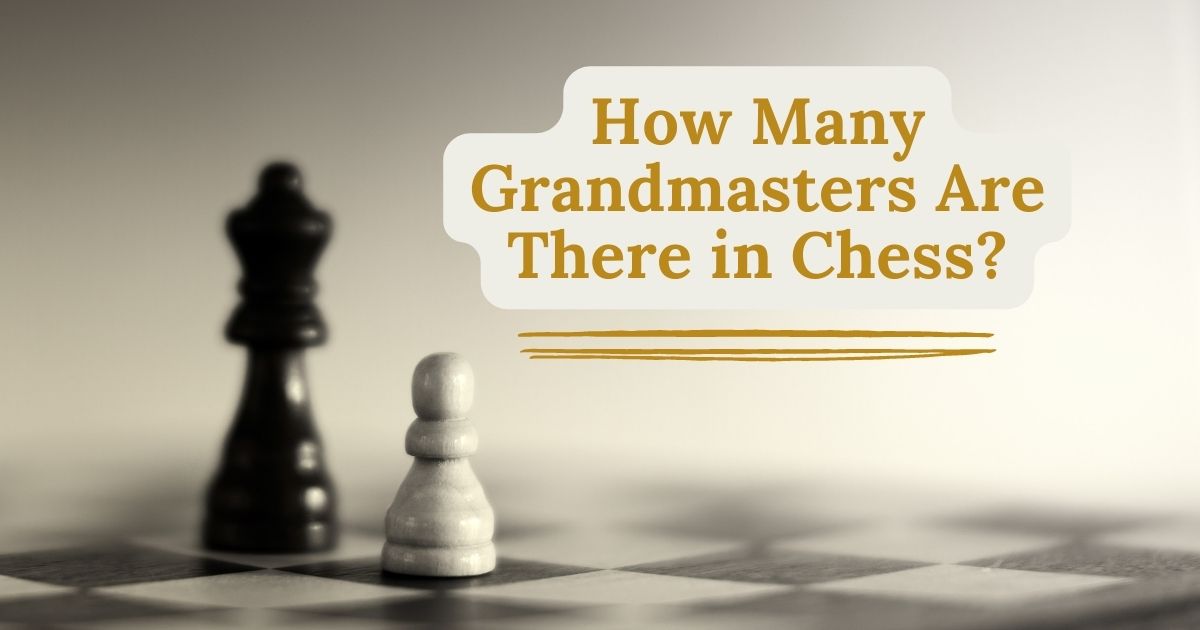What is a Chess Grandmaster?
What is a chess grandmaster, and how many grandmasters are there? The highest honor in chess is the grandmaster title. The International Chess Federation bestows chess titles. According to the FIDE rating list from September 2020, there are 1,721 grandmasters worldwide.
In this article, you will learn what it takes to become a grandmaster and how many grandmasters are there currently. The number fluctuates over time.

How Many Grandmasters are There in Chess?
Only 29 of the 1,725 grandmasters are female as of February 2021, with Hou Yifan of China, the youngest female grandmaster in history, having the highest standard rating of 2,658. She currently does not have a ranking that places her among the top 100 grandmasters.
In addition to the grandmaster title, there is the occasionally contentious “women’s grandmaster [WGM] title,” which requires about 200 fewer points to qualify than the official grandmaster rating.
Some cases—most notably those of Antoaneta Stefanova (2,470) and Pia Cramling (2,459)—do not involve people who are women’s grandmasters. Cramling, a longtime supporter of chess’s best players who insisted on competing in men’s tournaments and attained the grandmaster title in 1992, is still second only to Stefanova’s overall standings.
The Bulgarian reached her pinnacle as the second-ranked woman in 2003 and only attained grandmaster status almost ten years later, in 2002. She also won the title of Women’s World Champion in 2004.
Where to Find the Chess Grandmaster List?
You can find the chess grandmaster list online on google.
How to Become a Chess Grandmaster
You must accomplish the following two accomplishments to become a grandmaster. If you have an interest in the specifics, we advise you to examine the official FIDE manual because there is some fine print to read, and there are certain exceptions to these rules.
- Obtain a FIDE rating of more than 2,500.
- Acquire three GM norms.
To win a GM norm, you must accomplish a performance rating of 2,600 in a game that lasts at least nine rounds, in which one-half of your opponents have (FM, IM, GM, WGM, WIM) titles, and one-third of your opponents are grandmasters themselves.
Be at ease, though! This essay will concentrate on the measures you must take to fulfill those requirements, including where to begin, learn and train, develop a grandmaster’s mentality, and use the most recent advancements in chess science.
11 Steps to Become a Chess Grandmaster
Begin Young and Develop a Love for Chess
To become a GM, you must first learn how to play chess. You would have done it in a perfect world when you were the youngest. Magnus Carlsen began at age 5, while Abhimanyu Mishra, the world’s youngest-ever GM, started when he was just two and eight months old.
The prevailing consensus regarding joining the chess elite or becoming a GM is that the earlier you start, the better. However, starting before the age of 10 is not a requirement. Starting young gives you the optimal foundation to expand your chess knowledge because our minds are better at learning and internalizing patterns at such a young age.
Acquire Learning Skills
The next step will be to learn how to learn, assuming you have some skills in the game of chess and know that your passion for it is sufficient to continue on the path to grandmaster-dom. Former World Champion Vladimir Kramnik stated in an interview with chess24, “I think the definition of skill, particularly of talent in chess, is the ability to learn.”
Combine that with Garry Kasparov, a former World Champion and Kramnik’s fiercest competitor, who said: “Hard effort is a talent.” You start to understand what it takes to be successful at chess when you realize that persistence in the face of failure is a talent.
You need a lot of learning to become a general manager, so it makes sense to spend some time considering how you know and maximize this process best. For chess, you should commit to learning more about, expanding, and advancing the science of chess teaching. It boils down to three key ideas: scheduling, periodic repetition, and gamification.
To optimize chess learning, it is essential to comprehend how our brains function. The philosophy underlying Chessable’s spaced you can boil down repetition-based learning method.
This is because you retain information better if you revisit and review it repeatedly over a period that increases as it moves from your short-term memory to a more permanent location in your brain.
Build a Serious Opening Repertoire
What happens when you learn how to learn? Like many of the other items on this list, the following three actions are disciplines that, if you choose to become a grandmaster, will become an integral part of your life. As follows:
- Study openings.
- Train your tactical instincts.
- Master positional chess.
- Learn how to win endgames.
Openings will be the focus of this section. Everyone enjoys learning about openings. It is entertaining and addictive, and a little study can yield big rewards at lower levels. You must raise the bar as a would-be grandmaster.
You need to have a variety of opening weapons in which you have complete confidence and a general understanding of the primary lines in every critical opening. “Having preferences means having vulnerabilities,” famously remarked Magnus Carlsen. Aspiring GMs currently encounter competition on this level.
Develop Your Tactical Intelligence
Developing and honing your tactical instincts is the next step. Chess tactics are an essential and inevitable part of the game. Any grandmaster’s toolkit must include the ability to recognize when a move is appropriate. Most of this talent is from experience.
This instinct often enables a master player to focus their calculations on the best course of action. Thousands of games, similar positions, knowledge of structures, potential endgames, tactical patterns, and historical master games are all considerations in a GM’s mind when scanning a position for tactical shots or threats.
Years of play are, in many ways, the best way to develop this talent. You can use other, more direct methods to cultivate this inclination, though actively. GM Alex Colovic’s approach to training has its basis on knowledge of myelin. This material causes the synapses in our brains to fire more quickly.
To level up your chess antenna more quickly, you must find a means to include intensive chess study into your everyday schedule. For instance, having GM Judit Polgar quiz you on her opening strategies until you master them.
Master Positional Chess
As you learn the game, it’s common to put off developing your positional (or strategic) chess understanding, placing it behind opening planning and tactical considerations in the priority list.
This may be because many win or lose games at the opening, or one player made a tactical error. But as you advance in your quest for a title, having a solid understanding of strategy becomes increasingly crucial.
The initiative, pawn structures, prophylaxis, material vs. positional gains, and other ideas fall under the broad strategy category. The more skilled you get at chess, the more strategic considerations dominate your decision-making.
The rationale is that strategic thinking enables players to look beyond the current position on the board and consider how the position can evolve in the long run.
A master chess player will be able to make the numerous crucial decisions that determine the outcome of a game thanks to their understanding of when to attack, when to keep a position closed in their favor when to prioritize taking out a crucial defender over improving a minor piece, and other related situations.
Discover Endgames
Every club player has undoubtedly heard this a million times: learning endgames is essential if you want to increase your grade. Not getting around that chess endgames are what you need to live and breathe if you want to be a grandmaster, even if beginners frequently choose to study openings and middlegame positions over endgames.
There is a vast repository of positions and concepts that you need to be aware of to make wise choices near the finish of a chess game, including pawn endgames, pawn and rook endgames, opposite-colored bishops endgames, you name it.
You cannot, for instance, determine with certainty whether to trade (or not to trade) the remaining rooks on the board unless you are aware of your King+Pawn endgames. Studying the fundamentals of conflict. One of the numerous endgame ideas a GM will have to learn is the fundamentals of opposition.
There is an intriguing debate about the best way to study endgames. Which is more beneficial: memorizing endgame positions or learning to play them well? You must do both to become a general manager.
Developing your endgame technique will directly impact your ability to win chess games, move up rating ladders, and achieve outcomes more than any other aspect of your chess skill, even if it may seem less appealing than increasing your repertory of openings.
Once more, you need excellent options to help make this difficult task a little less intimidating. These options range from a digital edition of the classic 100 Endgames You Must Know to courses based on more practical and strategic learning, like Practical Endgames Volume I from GM Alex Yermolinsky, to expert territory like Nunn’s Chess Endings Volume 2.
Increase Your Understanding of Grandmaster Games
Congratulations if you’ve come this far! Even so, mastering the latter three components by themselves is insufficient. You need to learn everything there is to know about the game, from positional strategy to resource evaluation, initiative, and sacrifice to psychological factors like imagination and thought patterns and the stress of competition.
Your opponents will identify and take advantage of any weaknesses, so you must have perfect knowledge of the game. Building up your knowledge of great games from history is one of the best methods to master and develop your game holistically (a vital duty for any aspiring GM).
Acquire Thinking Skills
The other mountain you must climb to get to the top is a little more abstract, but it’s still essential. How do you develop GM-like thinking? How do you approach situations where the clock is ticking and numerous ideas, worries, and methods are vying for your attention?
How do you maintain awareness in every situation while avoiding instinctive movements that compromise your advantage? A necessary step to becoming a general manager is developing the right mentality.
You may take various approaches to understand this aspect of your game better and improve it, from visualization techniques to psychological research to philosophical musings.
The Moves that Matter, Chess for Zebras, and The Seven Deadly Chess Sins author, GM Jonathon Rowson, believes that the secret to reaching the top tiers of the chess rating ladder is to identify and eliminate psychologically and emotionally motivated errors and mistakes.
Master Game Analysis of Your Games
The best chess learning tool you have at your disposal is probably learning from your blunders, even though they can be terrible. Every game should end with you going over what transpired, thinking about how the game evolved and asking yourself the most revealing questions.
Every player will have their preferred method of game analysis. Still, generally speaking, the procedure entails importing the game into the analysis tool of your choice (like this one, perhaps), replaying the game without the aid of a computer, and remembering your candidate moves from a crucial moment.
Hire a Good Coach
You cannot attain a grandmaster on your own. Having someone in your camp to assist you with analysis, training, improvement, and game preparation is crucial as you advance and get closer to your goal of becoming a grandmaster.
This person not only understands your game as well as you do, but they can also offer new insight and perspectives that you alone might miss.
In addition to coaches, high-level players have “seconds,” who are comparable to coaches and assist with a variety of crucial jobs like planning opening plans for a given opponent, playing practice games made to correct a particular weakness discovered via research, and so forth.
One of the most crucial choices an aspiring grandmaster can make is choosing a good coach. This person will be your guide on the path to reaching your goal, and they will mold your play, technique, and learning curve more than anyone else, so make a reasonable choice!
Win and Keep Winning
Finally, there is no getting around the fact that winning many chess matches is a requirement to become a grandmaster. You need to have a strong desire to succeed, one that will sustain your motivation at an exceptionally high level for an extended period.
This is crucial to keep up the level of training necessary to achieve your goal and to continue fighting on the board even when all hope seems lost. A legendary chess player, Bobby Fischer, once said: “Chess is a war over the board. To break the opponent’s mind is the goal. These are the criteria by which you must judge every game in terms of competition.
To do this, you must become quite accustomed to competition and fine-tune your capacity to function in various situations. The best tip for this is to get in and start competing! An OTB competition will always teach you something, regardless of your skill level. So why are you still waiting? Step right up. And best of luck as you pursue the GM title.

The Youngest Chess Grandmaster in the World
It doesn’t change very often who holds the title of youngest grandmaster. It’s pretty close in the male class, but Hou Yifan has supplanted Judit Polgár as the highest-rated woman in the female grandmaster class.
Youngest Grandmaster Presently
Abhimanyu Mishra, a grandmaster from New Jersey in the United States who turned 18 in 2021, is the youngest current chess grandmaster.
Youngest Grandmaster in Chess History
The American chess prodigy from New Jersey, Abhimanyu Mishra, who is just 12 years, four months, and 25 days old, defeated Sergey Karjakin to claim the youngest grandmaster in chess history in 2021.
At 12 years, seven months, and 0 days, Sergey Karjakin became the youngest player to receive the title of grandmaster in the game of chess. Gukesh Dommaraju was only 17 days faster than him, but he lost the record after holding it for around 19 years. Abhimanyu Mishra is now the proud owner of that distinction.
There is some evidence that chess players perform best between the ages of 35 and 45, but younger and younger players are becoming better. Grandmasters are 32.9 years old on average.
List of Youngest Chess GMs In History
- 1950: David Bronstein Soviet Union (26 years)
- 1952: Tigran Petrosian Soviet Union (23 years)
- 1955: Boris Spassky Soviet Union (18 years)
- 1958: Bobby Fischer United States (15 years, six months, one day)
- 1991: Judit Polgár Hungary (15 years, four months, 28 days)
- 1994: Péter Lékó Hungary (14 years, four months, 22 days)
- 1997: Étienne Bacrot France (14 years, two months, 0 days)
- 1997: Ruslan Ponomariov Ukraine (14 years, 0 months, 17 days)
- 1999: Bu Xiangzhi China (13 years, ten months, 13 days)
- 2002: Sergey Karjakin Ukraine (12 years, seven months, 0 days)
- 2021: Abhimanyu Mishra United States (12 years, four months, 25 days)
The Oldest Chess Grandmaster Globally
In the world, Yuri Averbakh, born in 1922, is the oldest grandmaster. At the age of 88, Enrico Paoli (1908 to 2005) received the honorary grandmaster title. At 97 years old, he was actively engaging in chess games.
How Many Female Grandmasters are There?
Only 29 of the 1,725 grandmasters are female as of February 2021, with Hou Yifan of China, the youngest female grandmaster in history, having the highest standard rating of 2,658. She currently does not have a ranking that places her among the top 100 grandmasters.
In addition to the grandmaster title, there is the occasionally contentious “Women’s grandmaster (WGM) title,” which requires about 200 fewer points to qualify than the official GM rating.
Only 29 of the 1,725 grandmasters are female as of February 2021, with Hou Yifan of China, the youngest female grandmaster in history, having the highest standard rating of 2,658. She currently does not have a ranking that places her among the top 100 grandmasters.
In addition to the grandmaster title, there is the occasionally contentious “Women’s grandmaster (WGM) title,” which requires about 200 fewer points to qualify than the official GM rating. Some cases—most notably those of Antoaneta Stefanova (2,470) and Pia Cramling (2,459)—do not involve people who are Women’s grandmasters.
Cramling, a longtime supporter of chess’s best players who insisted on competing in men’s tournaments and attained the grandmaster title in 1992, is still second only to Stefanova’s overall standings.
The Bulgarian reached her pinnacle as the second-ranked woman in 2003 and only attained grandmaster status almost ten years later, in 2002. She also won the title of Women’s World Champion in 2004.
Some cases—most notably those of Antoaneta Stefanova (2,470) and Pia Cramling (2,459)—do not involve people who are women’s grandmasters. Cramling, a longtime supporter of chess’s best players who insisted on competing in men’s tournaments and attained the grandmaster title in 1992, is still second only to Stefanova’s overall standings.
The Bulgarian reached her pinnacle as the second-ranked woman in 2003 and only attained grandmaster status almost ten years later, in 2002. She also won the title of Women’s World Champion in 2004.
Who was the First Female Grandmaster?
Nona Gaprindashvili attained this rank at 37 and was the first woman to receive the FIDE’s grandmaster title. She speaks extensively about how people don’t take female athletes seriously and how much more effort you require to achieve the same level of success as a guy.
Due to a lack of peers at your level willing to take you seriously and accept your challenge as an opponent, you may experience stagnation in your rating as a result, which could have an unanticipated effect on the Elo rating of female chess grandmasters.
FIDE provides a separate list of female grandmasters (WGM) who have that title, allowing for quicker acknowledgment of female players (although these players can also rank in the main list). Here are the top-ranked female players according to the FIDE as of 2021.
The Country With the Most Grandmasters
Russia has the most active grandmasters in chess, with 108, followed by the United States and Germany, who take the second and third spots, respectively. The Czech Republic, Armenia, and Georgia are the nations with the highest ratio of grandmasters to population.
It is not surprising that Russia and many former Soviet states are at the top of the Top 100 Countries for grandmasters list because chess is a compulsory subject in their educational systems.
Therefore, there is one grandmaster in chess for every 56,250 Russians. When compared to, say, India, that density is decent. Compared to their enormous 1,366,000,000 population, which equals just 1 in 21 million, they rank fifth in terms of the number of grandmasters.

We’ve Got You Covered
Therefore, it is time for you to put effort into rising to a ranking of 2,500 and becoming a grandmaster. It’s not a simple task. Once you are on the map, it takes more than three years to become a grandmaster in chess, and it takes even longer to reach that level.
As we’ve seen, individuals as young as twelve attain the grandmaster status. Still, according to PNAS, which used chess for its research and published a paper titled “Life cycle patterns of cognitive performance over the long run,” grandmasters exhibit their peak performance between the ages of 35 and 45.

